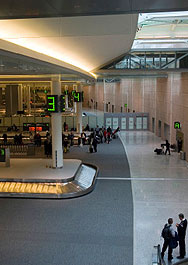The optimistic scenario
By Kiron Kasbekar | 20 Jan 2007
 More than a decade ago, people in the tourism trade complained that there was no way India's tourism revenues could rise unless it improved and expanded its airport infrastructure. Businessmen in every industry complained of how the weak airport infrastructure is a hindrance to growth.
More than a decade ago, people in the tourism trade complained that there was no way India's tourism revenues could rise unless it improved and expanded its airport infrastructure. Businessmen in every industry complained of how the weak airport infrastructure is a hindrance to growth.
There has been some improvement; but the complaints have not gone away. The good news is that the Indian government's recent initiatives should result in a marked improvement in the airport infrastructure in the next five years.
A policy on airport infrastructure prepared by the Indian government in 1997 allowed foreign companies to own up to 74 per cent of the equity of airport projects with automatic approvals, and up to 100 per cent equity with special permission. In order to encourage private participation in the airport infrastructure sector, the government has recently liberalised the norms and allowed up to 100 per cent foreign equity through the automatic route, for setting up greenfield airport projects.
Management of the country's biggest airports, at Delhi and Mumbai, has been handed over to the private sector, including foreign participants. And the Airports Authority of India (AAI) has been asked to expedite the upgrade of many major and minor airports. (For details of airport modernisation and expansion plans, see 'Major airports will ride high' and 'Non-metro airports look up'.)
Where will they land?
All of which is fine. But new demands are likely to be made, which were not foreseen a couple of years ago. India's civil aviation ministry seems content when it talks of building facilities at 80 airports in the country. It needs to look at more locations. It doesn't necessarily have to take the responsibility of developing all of them.
As the pace of business expansion accelerates, businessmen are realising that it makes sense to own or use private aircraft to improve timeliness of internal and external business interaction. Estimates of demand for private jets and helicopters run into the hundreds. Add to that the similar needs of senior government officials and services like police and healthcare, and the number could easily be counted in the thousands.
Where are all these aircraft going to land? And where are they going to be able to park? And how will they be serviced by the range of operations needed, from air traffic control, instrument landing systems to fuelling, maintenance and emergency systems?
India's aviation infrastructure requirement is unlike that of most countries in the world, with the exception of a few, such as the US, Russia and China. Great distances, numerous important state and district administrative centres, and a large number of locations of manufacturing and utility plants, plus a plethora of tourist sites of historical and pilgrim interest - the number of airports should run into hundreds instead of the 75 or so that we have today, including many seldom-used sites.
The key will be a structure in which international and major national airports will form the base, and numerous mid-size, small airports - and even small airstrips - will connect to them. The advent of small aircraft, and even 'very light jets', owned by businessmen, government agencies and by air taxi operators, will need an extensive network of airports and airstrips.
A delusion?
The thought of small aircraft requiring shorter airstrips, which can be strewn across the country, and therefore not needing a massive expansion of the major airports, could be a delusion. Small aircraft may be useful to arrive at low-traffic, small airstrips closer to tourist or business destinations; but their users are likely to originate in the main city centres.
It is not enough to provide landing facilities. Aircraft need to be parked when they are not used. And, if their places of origin are the main city centres, then the airports in or around these city centres will have to have expanded parking as well as take-off and landing space.
In other words, small aircraft will not reduce the pressure on major airports. They will actually increase the pressure. The alternative will be feeder airports with helicopter services that can land passengers on helipads in designated public spaces or on building-tops.
Airport infrastructure is more than just airstrips. Air traffic control systems will have to be strengthened as we see a steep increase in the number of aircraft and flights, including an unprecedented level of unscheduled flights by private owners of small aircraft and air-taxi operators.
The government is enhancing the quality of aviation-related communication systems, vital for navigation and landing. The Airports Authority of India is shifting from terrestrial links to "a dedicated satellite communication network (DSCN) for meeting all operational communication requirements of air traffic services", according to a civil aviation ministry note, which adds that "the system will have VSAT terminals at 80 airports with full redundancy".
Now the government needs to figure out how the entire system can cater to the requirements of not just 80 airports in key cities but hundreds of them across India. For, unless it puts artificial restrictions on the development of new airports, it will not be able to stop the explosive growth in air transport.
Nor will the government be able to cope with the demand with its own resources. It will have to allow the private sector to build and operate more airports. Only, it must make sure that it doesn't end up providing financial guarantees where they are not necessary. The private sector must bear the risk. The rewards could be huge.



















.jpg)










